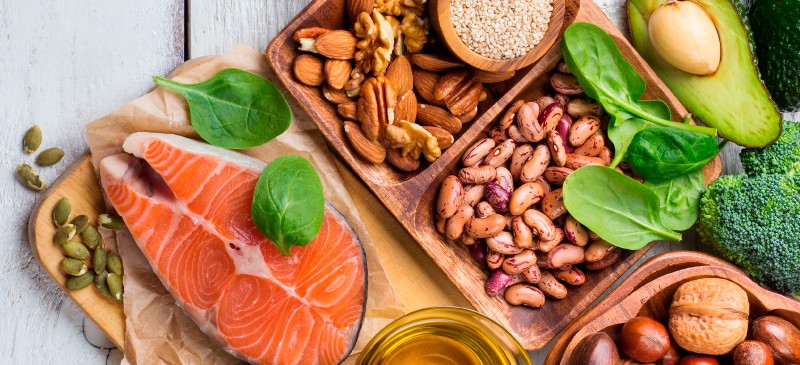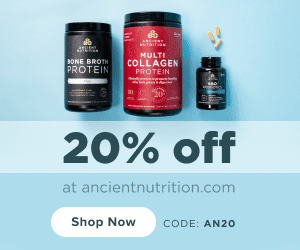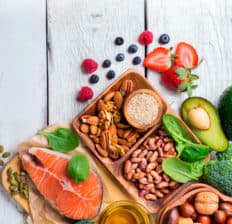This Dr. Axe content is medically reviewed or fact checked to ensure factually accurate information.
With strict editorial sourcing guidelines, we only link to academic research institutions, reputable media sites and, when research is available, medically peer-reviewed studies. Note that the numbers in parentheses (1, 2, etc.) are clickable links to these studies.
The information in our articles is NOT intended to replace a one-on-one relationship with a qualified health care professional and is not intended as medical advice.
This article is based on scientific evidence, written by experts and fact checked by our trained editorial staff. Note that the numbers in parentheses (1, 2, etc.) are clickable links to medically peer-reviewed studies.
Our team includes licensed nutritionists and dietitians, certified health education specialists, as well as certified strength and conditioning specialists, personal trainers and corrective exercise specialists. Our team aims to be not only thorough with its research, but also objective and unbiased.
The information in our articles is NOT intended to replace a one-on-one relationship with a qualified health care professional and is not intended as medical advice.
Dr. Axe’s Healing Foods Diet (What to Eat & What to Avoid)
April 9, 2023

What you grab at the grocery store can have a huge impact on overall health. In fact, while loading your cart up with refined grains, sugary drinks and processed foods can increase inflammation and tank energy levels, filling up on healthy, healing foods can help keep you feeling your best and protect against chronic disease.
The healing foods diet is designed to heal the body and improve health by encouraging the consumption of nutritious, whole foods like fruits, veggies and healthy fats.
Plus, this simple eating pattern is a great way to ensure you supply your body with a steady stream of the nutrients you need to help prevent nutritional deficiencies in your diet.
Healing Foods Diet Principles
The healing foods diet is an eating plan that focuses on replacing refined, processed and inflammatory ingredients in your diet with nutritious, whole food alternatives to promote better health.
The diet includes a few simple steps that involve making some simple switches in your diet. Best of all, unlike other diets with extensive, complicated rules and regulations, the healing foods diet relies on three basic principles:
1. Swap out Unhealthy Fats
Trading unhealthy fats for healthier options is one of the key components of the healing foods diet.
This is because unhealthy fats, such as hydrogenated and partially hydrogenated oils, trans fats and refined vegetable oils, can cause chronic inflammation and may contribute to conditions like heart disease, stroke, diabetes and cancer.
Healthy fats, on the other hand, are essential for everything from hormone production to cancer prevention, brain development and weight loss.
2. Change the Meats You Eat
Selecting sustainable sources of meat not only helps support ethical farming practices and minimizes your environmental impact, but it may also be better for your health as well.
For instance, grass-fed beef is significantly higher in heart-healthy omega-3 fatty acids than grain-fed varieties and is also richer in conjugated linoleic acid, a type of fatty acid that has been associated with a multitude of health benefits.
Similarly, wild-caught fish is lower in calories, higher in important minerals and less likely to be contaminated by harmful toxins than conventional farmed fish.
3. Remove Refined Sugars and Grains
During processing, refined grains are stripped of many important vitamins and minerals, producing a final product high in calories, carbs and sugar but lacking in essential nutrients.
White rice, pasta and noodles are a few examples of refined grains that are low in the important micronutrients that your body needs. Swapping these foods out for healthy whole grain alternatives is a great way to squeeze some extra vitamins and minerals into your diet to support healing.
Related: Improve Your Diet & Health with a Clean Eating Meal Plan
Benefits
1. Decreases Inflammation
Acute inflammation is a normal part of the immune process that helps protect the body against foreign invaders. Chronic inflammation, on the other hand, can contribute to conditions like heart disease, obesity and diabetes.
While some foods can increase markers of inflammation, others can help fight inflammation and aid in the prevention of chronic disease.
Plant-based foods like fruits and veggies, in particular, are linked to lower levels of inflammation in the body.
2. Improves Heart Health
As the leading cause of death around the world, heart disease accounts for around 31.5 percent of deaths globally.
Making a few simple swaps in your diet and filling up on heart-healthy foods as part of the healing foods diet is a simple way to reduce the risk of heart disease to keep your heart healthy and strong.
Healthy fats, high-fiber foods and antioxidant-rich fruits and veggies are all plentiful on the healing foods diet and can help protect against conditions like high blood pressure, heart disease and stroke.
3. Stabilizes Blood Sugar
Sustaining high blood sugar levels can be detrimental to overall health. Not only can it worsen diabetes symptoms and cause serious side effects like vision loss and nerve damage, but it can also lead to a condition known as insulin resistance.
Insulin is the hormone responsible for transporting sugar from the bloodstream to the cells. When you load up with lots of high-carb, sugary foods, it increases levels of both blood sugar and insulin.
Over time, maintaining high levels of insulin in the blood can impair your body’s ability to use it efficiently, spiking blood sugar levels and throwing hormones out of whack.
Not only is the healing foods diet low in unhealthy ingredients that can contribute to insulin resistance, but it’s also rich in high-fiber, nutrient-dense foods to support better blood sugar control.
4. Rich in Minimally Processed Ingredients
Shockingly, some studies estimate that nearly 58 percent of total daily calories in the average American diet come from ultra-processed foods. These foods are stripped of their nutritional value and associated with a long list of health issues, including heart disease, cancer and even death.
All foods included on the healing foods diet are minimally processed. This helps maximize their nutrient content and reduces the risk of adverse health effects associated with other processed ingredients.
5. Prevents Nutritional Deficiencies
In addition to promoting healing with whole foods, the healing foods diet also ensures you get the important vitamins, minerals and antioxidants your body needs to support overall health.
Nutritional deficiencies can cause a slew of negative symptoms, including low energy levels, fatigue, anemia, bone loss and brain fog.
Filling your plate with a variety of foods that promote healing as part of the healing foods diet helps provide important vitamins and minerals to prevent nutritional deficiencies.
What to Eat
The healing foods diet is rich in nutritious whole foods, including fruits, veggies, nuts, seeds, legumes and healthy fats. While a plant-based diet is primary, grass-fed meat, wild-caught fish and organic poultry are also permitted as part of the plan, along with an assortment of healthy condiments, herbs and spices.
Here are a few ingredients you can enjoy as part of the healing foods diet:
- Fruits: strawberries, oranges, lemons, blackberries, limes, raspberries, pears, apples, blueberries, etc.
- Vegetables: broccoli, cabbage, bell peppers, Brussels sprouts, tomatoes, asparagus, garlic, cucumber, onions, ginger, etc.
- Nuts: almonds, cashews, pecans, pistachios, macadamia nuts, walnuts, Brazil nuts
- Seeds: hemp seeds, pumpkin seeds, sunflower seeds, chia seeds, flaxseeds
- Legumes: black beans, kidney beans, pinto beans, lima beans, chickpeas, lentils
- Whole grains: quinoa, barley, buckwheat, millet, brown rice
- Healthy fats: olive oil, coconut oil, MCT oil, grass-fed butter, ghee, avocado oil
- Dairy products: goat milk, kefir, goat cheese, probiotic yogurt, raw milk
- Meat: grass-fed beef, lamb, venison, wild game
- Fish: wild-caught salmon, tuna, mackerel, anchovies, sardines
- Poultry: organic chicken, turkey, goose, duck
- Cage-free eggs
- Condiments: hummus, guacamole, apple cider vinegar, mustard, salsa, balsamic vinegar, liquid aminos
- Herbs and spices: basil, oregano, rosemary, turmeric, cinnamon, paprika, cumin, black pepper, etc.
- Natural sweeteners: stevia, raw honey, maple syrup, dates, monk fruit
- Beverages: water, tea, kombucha, bone broth
Foods to Avoid
Just as important as filling up on the right foods on the healing foods diet is limiting your consumption of unhealthy, pro-inflammatory ingredients.
Not only are these foods typically high in calories, sodium and added sugars, but they can also contribute to the development of chronic disease.
Here are a few foods you should restrict as part of the healing foods diet:
- Refined grains: white rice, pasta, white bread, breakfast cereals
- Added sugars: soda, juice, candies, cookies, granola bars, baked goods, ice cream
- Unhealthy fats: refined vegetable oils, shortening, hydrogenated fats, fried foods
- Conventional meat and poultry
- Farmed fish
- Processed foods: potato chips, crackers, frozen meals, microwave popcorn, processed meat, instant noodles, etc.
Recipes
Whether you’re a professional chef or kitchen novice, there are tons of options to enjoy the variety of foods included on the healing foods diet.
Here are a few nutritious and delicious recipes you can use to help get you started:
- Tropical Acai Bowl with Mango and Hemp Seeds
- Moo Shu Chicken Lettuce Wraps
- Crustless Spinach Quiche
- Grilled Honey Glazed Salmon
- Vegan Paleo Apple Fritters
Conclusion
- The healing foods diet is a simple eating plan that involves limiting consumption of refined grains, added sugars, unhealthy fats and processed ingredients.
- Instead, the diet encourages nutritious, whole foods, including fruits, veggies, legumes, healthy fats, organic meats and healing herbs and spices.
- Filling up on these healthy ingredients can reduce inflammation, protect against heart disease, stabilize blood sugar levels and prevent nutritional deficiencies.
- These healing foods could also potentially aid in the prevention of chronic conditions, including heart disease, stroke, diabetes and cancer.











